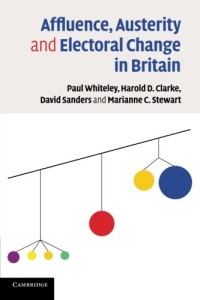How voters decide who to vote for: Affluence, Austerity and Electoral Change in Britain
The core thesis of Affluence, Austerity and Electoral Change in Britain is that Britain’s recent general elections have been decided by “valence factors” – that is ones where voters choose between parties based on evaluation of their competence rather than making choices based on competing ideologies. Voters evaluate competency and credibility rather than competing lists of policy options.
With the more recent rise of Ukip and, to a lesser extent, the Greens, it is far from clear that valence factors continue to dominate British politics but even so there are plenty of pointers to understanding current and future politics from this study of the past, with its detailed statistical analysis of polling data from the British Election Study over 15 years.
 In particular, for the Liberal Democrats an emphasis on valence rather than policy positions helps explain the party’s low poll ratings during the 2010-15 Parliament despite polling finding individual policies popular and the party’s position on the left/right political spectrum close to that of voters. The challenge the party faces isn’t about policies but about the party’s perceived ability to deliver on what it believes in.
In particular, for the Liberal Democrats an emphasis on valence rather than policy positions helps explain the party’s low poll ratings during the 2010-15 Parliament despite polling finding individual policies popular and the party’s position on the left/right political spectrum close to that of voters. The challenge the party faces isn’t about policies but about the party’s perceived ability to deliver on what it believes in.
It also helps explain why the economic recovery during the 2010-15 Parliament boosted the Conservative poll rating more than the Lib Dem one (even if not as much as Conservatives hoped). As the authors wrote in the first half of the Parliament of their statistical analysis: “A telling difference between the Conservative and Liberal Democrats is that the former party’s prospects were enhanced by public perception that the Coalition Government is handling the crisis well … However, this was not the case for the latter party … This finding implies that the Conservatives are likely to be credited for an economic revival if their current strategy proves to be successful, but their Liberal Democrat partners will not be so fortunate”.
Skilfully done as the analysis of evidence and crunching of numbers is, it would be wrong to simply assume that all its findings are correct as there are some controversial ones in there. Most notably, their finding that socio-demographic factors only have a “very limited” influence on people’s voting patterns, once you allow for other factors such as perceived competence and party identification. Given the big socio-demographic variations between rock solid safe Labour seats and rock solid safe Conservative seats, it isn’t clear how the book’s overall conclusion about national politics matches up with the evidence of variation between constituencies.
Moreover, there is a potentially serious flaw in the attempts to factor in levels of campaign activity when making sophisticated statistical analysis. What the models use is the level of expenses declared on constituency expense returns. This requires an assumption (untested in the book) that money alone acts as a good proxy for the combination of both money and volunteer effort which matters in practice. It also requires the assumption that it is safe to ignore campaign expenditure which is concentrated in particular areas but done in a way that counts against national limits only and so does not appear in those local returns.
The problem with both those assumptions is that it is quite possible that they are untrue for different parties to different extents, thereby distorting the results. It’s true that trying to cater for these wider factors takes you away from the safe ground of precise, documented figures – but in this case it seems like a set of risky assumptions have been made (and ones which are not really even mentioned in passing in the book).
On a much narrower point, that of the importance of the popularity of Liberal Democrat leaders in that party’s support, Paul Whiteley and colleagues find that it is an important factor – a different finding from that of Johnston and Pattie in Putting Voters in Their Place.
So a lot to chew over in this informative, if at times rather technical, book but also plenty to judge carefully against other evidence.
One small point about the book’s production qualities: take care to keep it completely dry as it has one of those covers that starts to peel apart once moisture gets in the edges.
If you like this, you might also be interested in Talking to a brick wall by Deborah Mattinson.
Got a view on this review? Then please rate it on Amazon.
Leave a Reply